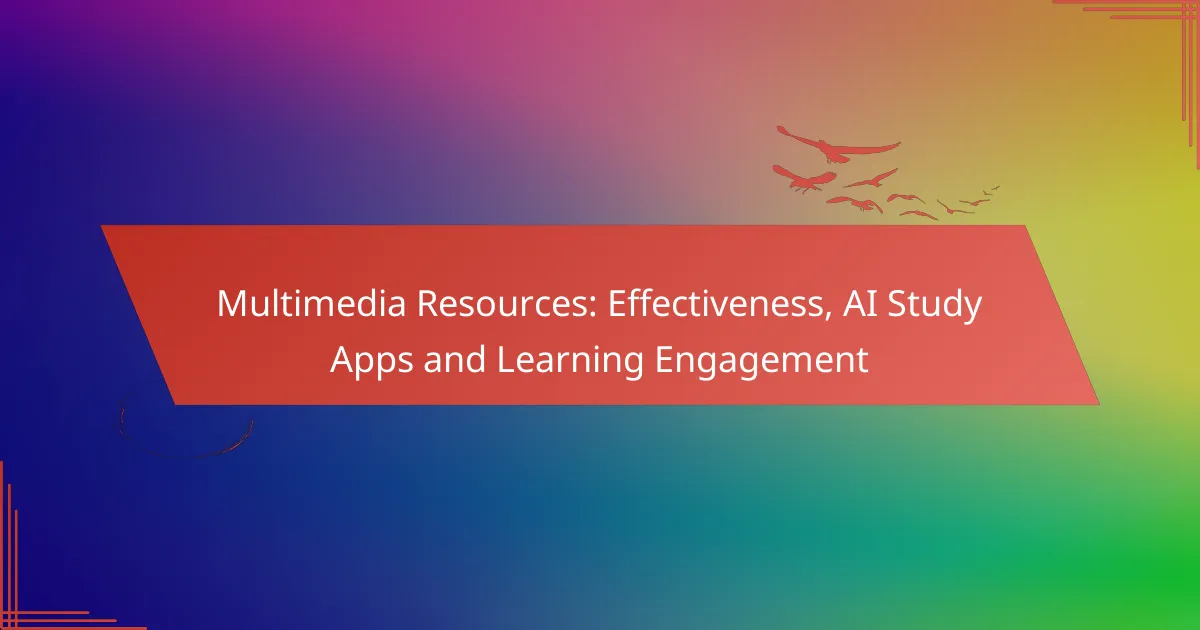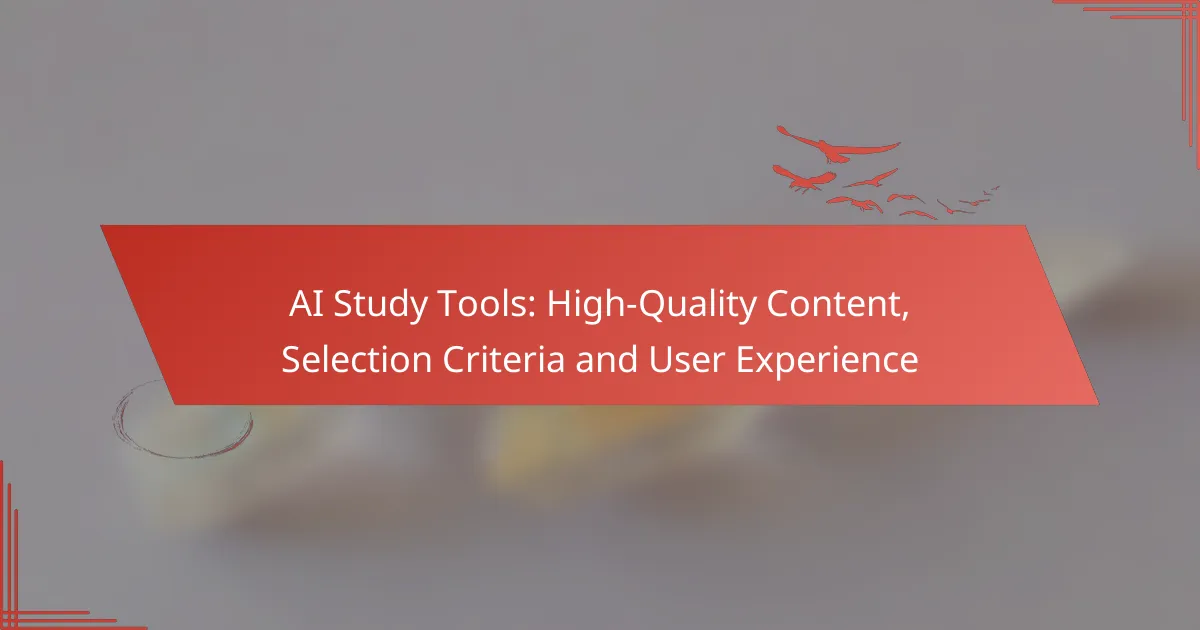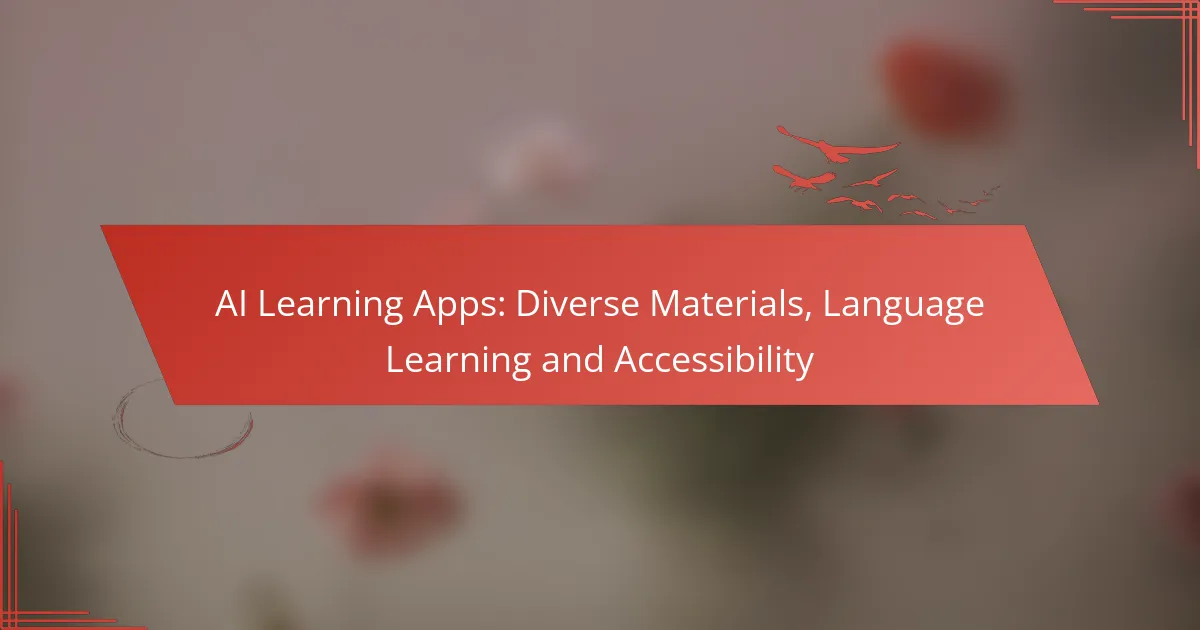Multimedia resources play a crucial role in enhancing learning effectiveness by integrating diverse formats like text, audio, and visuals, which cater to various learning styles. Additionally, AI study apps elevate engagement by personalizing content and offering interactive experiences, making study sessions both effective and enjoyable.

How Effective Are Multimedia Resources in Learning?
Multimedia resources significantly enhance learning effectiveness by combining various formats such as text, audio, and visuals. This approach caters to different learning styles and improves information retention and engagement.
Increased retention rates
Multimedia resources can lead to higher retention rates compared to traditional learning methods. Studies suggest that learners retain information better when it is presented through a combination of visuals and audio, as these formats create stronger cognitive connections.
For instance, using videos alongside written content can help reinforce key concepts, making them easier to remember. Incorporating interactive elements, such as quizzes or simulations, can further enhance retention by actively involving learners in the material.
Enhanced engagement levels
Engagement levels tend to rise when multimedia resources are utilized in educational settings. The use of dynamic content, such as animations or interactive modules, captures learners’ attention more effectively than static text.
For example, educational apps that incorporate gamification elements can motivate learners to participate more actively. This increased engagement often translates into a deeper interest in the subject matter, fostering a more enjoyable learning experience.
Improved understanding of complex concepts
Multimedia resources facilitate a better understanding of complex concepts by breaking down information into digestible segments. Visual aids, such as diagrams or infographics, can clarify intricate ideas that might be challenging to grasp through text alone.
Additionally, simulations and interactive scenarios allow learners to explore concepts in a practical context, enhancing comprehension. For example, a virtual lab can help students understand scientific processes by allowing them to experiment in a controlled environment, bridging the gap between theory and practice.

What AI Study Apps Enhance Learning Engagement?
AI study apps significantly boost learning engagement by personalizing content and providing interactive experiences. These applications adapt to individual learning styles, making study sessions more effective and enjoyable.
Quizlet
Quizlet is a versatile study tool that employs flashcards, quizzes, and games to enhance learning. Users can create their own study sets or access millions of existing ones, covering a wide range of subjects.
One of its key features is the “Learn” mode, which adapts to the user’s progress, focusing on areas that need improvement. This personalized approach can lead to better retention of information.
To maximize effectiveness, consider setting specific study goals and using the app regularly. Avoid cramming; instead, spread out your study sessions over days or weeks for better long-term retention.
Duolingo
Duolingo is a language-learning app that gamifies the process of acquiring new languages. It uses bite-sized lessons and interactive exercises to keep learners engaged and motivated.
The app employs a spaced repetition system, which helps reinforce vocabulary and grammar over time. Users can track their progress and earn rewards, making the learning experience enjoyable.
For optimal results, practice daily, even if only for a few minutes. Avoid skipping lessons, as consistency is key to language retention and fluency.
Notion
Notion is a powerful organizational tool that can enhance learning engagement by allowing users to create customized study spaces. It combines notes, databases, and task management in one platform, making it ideal for students.
With Notion, users can create interactive study guides, track assignments, and collaborate with peers. Its flexibility allows for various layouts, from simple lists to complex databases, catering to different learning preferences.
To make the most of Notion, start by structuring your study materials clearly. Use templates for consistency and integrate multimedia resources to enrich your learning experience. Avoid cluttering your workspace, as a clean layout can improve focus and productivity.

How to Choose the Right Multimedia Resources?
Selecting the right multimedia resources involves aligning them with your educational goals, assessing user engagement, and ensuring accessibility. These factors help maximize learning effectiveness and keep learners motivated.
Assess learning objectives
Begin by clearly defining your learning objectives. Determine what knowledge or skills you want learners to acquire and how multimedia can support these goals. For example, if the objective is to improve language skills, consider resources that incorporate interactive dialogues or visual aids.
Use the SMART criteria—Specific, Measurable, Achievable, Relevant, Time-bound—to refine your objectives. This clarity will guide your selection of multimedia tools that best fit the intended outcomes.
Evaluate user engagement metrics
Engagement metrics are crucial in assessing the effectiveness of multimedia resources. Look for data on user interaction, such as time spent on tasks, completion rates, and feedback scores. High engagement often correlates with better learning retention.
Consider tools that provide analytics, allowing you to track how users interact with the content. For instance, platforms that show completion rates above 70% might indicate effective engagement, while lower rates could signal a need for adjustment.
Consider accessibility features
Accessibility is essential to ensure that all learners can benefit from multimedia resources. Check for features such as captions, audio descriptions, and compatibility with screen readers. These elements help accommodate diverse learning needs.
Familiarize yourself with accessibility standards, such as the Web Content Accessibility Guidelines (WCAG). Aim for resources that meet at least Level AA compliance to ensure a broader reach and inclusivity in learning environments.

What Are the Benefits of Using AI in Education?
AI enhances education by providing tailored learning experiences, immediate feedback, and the ability to accommodate a wide range of learners. These benefits lead to improved engagement and effectiveness in educational settings.
Personalized learning experiences
AI enables personalized learning by analyzing individual student data to tailor content and pacing to their unique needs. For example, platforms like DreamBox and Knewton adjust math problems based on a student’s performance, ensuring they are neither too easy nor too difficult.
This customization helps maintain student interest and motivation, as learners can progress at their own pace. Schools can implement AI tools to create adaptive learning paths that align with each student’s strengths and weaknesses.
Real-time feedback
AI provides real-time feedback, allowing students to understand their mistakes and learn from them instantly. Tools such as Grammarly and Quizlet offer immediate corrections and suggestions, which can significantly enhance the learning process.
Receiving prompt feedback helps students adjust their learning strategies quickly, fostering a more effective study routine. Educators can also use AI-driven analytics to monitor student progress and intervene when necessary.
Scalability for diverse learners
AI solutions can scale to accommodate diverse learners, making education more accessible. For instance, language learning apps like Duolingo use AI to cater to various proficiency levels, ensuring that both beginners and advanced learners receive appropriate challenges.
This scalability allows educational institutions to serve larger groups without compromising the quality of instruction. By integrating AI, schools can offer a wider range of resources and support tailored to different learning styles and backgrounds.

What Are the Challenges of Implementing Multimedia Resources?
Implementing multimedia resources in education can be hindered by various challenges, including technical limitations, concerns about content quality, and the cost of subscription services. Addressing these issues is crucial for effective integration and maximizing learning engagement.
Technical limitations
Technical limitations can significantly impact the effectiveness of multimedia resources. Issues such as inadequate internet bandwidth, outdated hardware, or incompatible software can prevent seamless access to educational materials. Ensuring that both educators and learners have the necessary technology is essential for successful implementation.
Moreover, technical support is often required to troubleshoot problems that arise during use. Institutions should consider investing in IT resources to assist users and maintain system functionality, which can help mitigate these challenges.
Content quality concerns
Content quality is a critical factor in the effectiveness of multimedia resources. Poorly designed materials can lead to confusion and disengagement among learners. It is essential to evaluate the credibility, accuracy, and relevance of the content before integrating it into the curriculum.
Additionally, multimedia resources should be aligned with educational standards and learning objectives. Regular reviews and updates of the content can help maintain its quality and ensure that it meets the evolving needs of learners.
Cost of subscription services
The cost of subscription services for multimedia resources can be a barrier for many educational institutions. Prices can vary widely, often ranging from low monthly fees to substantial annual costs, depending on the platform and content offered. Institutions should assess their budget and prioritize resources that provide the best value for their specific needs.
To manage costs effectively, consider exploring free or open-source multimedia options that can supplement paid resources. Collaborating with other institutions to share subscriptions or resources can also help reduce expenses while enhancing access to quality materials.

How Do Multimedia Resources Impact Student Motivation?
Multimedia resources significantly enhance student motivation by making learning more engaging and interactive. By incorporating various formats such as videos, animations, and interactive simulations, educators can capture students’ attention and foster a deeper interest in the subject matter.
Increased interest in subjects
Multimedia resources can spark greater interest in subjects by presenting information in dynamic ways. For example, a science lesson that includes video demonstrations of experiments can make complex concepts more accessible and exciting. This approach can lead to a more enthusiastic learning environment, encouraging students to explore topics further.
Additionally, the use of gamified elements in educational apps can transform traditional learning into an enjoyable experience. When students engage with content that feels more like a game, their curiosity and desire to learn can increase significantly.
Higher participation rates
Utilizing multimedia resources often results in higher participation rates among students. Interactive elements, such as quizzes and polls integrated into lessons, can encourage students to actively engage rather than passively consume information. This active involvement can lead to better retention and understanding of the material.
Moreover, students who might be reluctant to participate in traditional classroom settings may feel more comfortable expressing their thoughts and ideas through multimedia platforms. For instance, online discussion forums or collaborative projects using digital tools can provide a less intimidating environment for participation.



